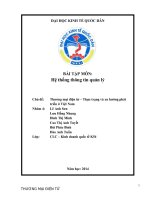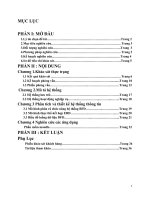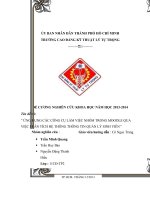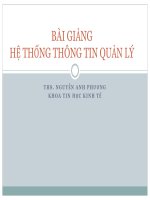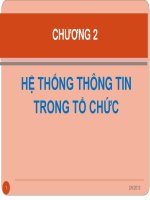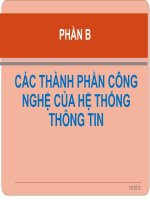MODULE 3 HỆ THỐNG THÔNG TIN QUẢN LÝ
Bạn đang xem bản rút gọn của tài liệu. Xem và tải ngay bản đầy đủ của tài liệu tại đây (19.1 KB, 4 trang )
GEOS2300/7300
STUDY MODULE 3
CONSERVATION: HABITAT ANALYSIS FOR
WILDLIFE
DUE DATE: 23rd May 2003
MARKS: 10
AIMS:
The objectives of this study module are:
1. to test your skills in ArcGIS (esp. spatial and attribute queries, creating charts,
attribute table manipulation)
2. to show an understanding of how ArcGIS can be used to address this problem
3. to examine the distribution of koalas and their habitat in Noosa Shire
PROBLEM:
Noosa Shire is undergoing rapid development, and so much natural vegetation has
been cleared. This has had a huge impact on the koala population in Noosa Shire as
their habitat is being depleted (for agriculture, urban development, etc.). In order to
protect and manage the koala population and ensure their survival, it is important to
know where the koalas are located, the suitability of land for habitation by koalas and
the spatial extent and distribution of their habitat. Proximity to roads and other urban
features are also important. This knowledge will provide a better understanding of the
distribution and habitat of koalas. Such information can then be used to assess
whether the existing land-uses or restrictions are adequate for the survival of this
koala population or they need to be revised. In order to address these issues you have
been given some data on the vegetation types in Noosa Shire, the suitability of
habitats for koalas, land parcels (DCDB), roads and koala find spots.
WORK RESOURCES:
All data for this module is stored in the Module 3 folder on the S drive:
\\ATLAS2\Students\COURSES\GEOS2300
Data:
Remveg_shire.shp – this dataset contains information on the vegetation and suitability
of vegetation types for koalas in Noosa Shire. It contains a number of fields
on vegetation classes (uveg, uveg1, uveg2, uveg3, etc.) which you do not need
to worry about. The fields you are interested in are: Key, Descriptio and Area.
The Key and Descriptio fields record the suitability of the habitat for koalas
(according to tree species). The following values in the ‘Key’ field - 1, 2, 3, 4,
5 – equate to the following values in the ‘Descriptio’ field - primary, 2A, 2B,
2C and tertiary respectively. According to this classification Primary = >50%
preferred tree species, 2A = 30-50% preferred tree species, 2B = 10-30%
preferred tree species, 2C = <10% preferred tree species and Tertiary =
disturbed or marginal land. The other values in the ‘Key’ field relate to land
unsuitable for koalas – 6 = unknown, 7 = other, 8 = Plantation, 9 = Clear, 99 =
water. This dataset is in AMG66 zone 56 coordinates.
Presabs_koala.dbf – this is a table recording whether koalas were sighted or not at
particular sample locations throughout Noosa Shire. It records the following
data: OID (object identification), PA_site (site code), Easting (Easting in
AMG66 coordinates), Northing (Northing in AMG66 coordinates), ALT
(altitude above sea level), Pres-abs (presence or absence of koalas – 0 means
no koalas were sighted and 1 means koalas were sighted).
Noosa_cad.shp – this layer is a DCDB for Noosa Shire. It contains a large number of
fields, most of which you do not need to worry about. The main field you are
interested in is the Tenure field which contains the following tenure codes: AP
(Action Pending), CL (Commonwealth Land), FH (Freehold), HL (Housing
Land), ID (Industrial Estates), LL (Lands Lease), NP (National Park), PH
(Port and Harbour Boards), RE (Reserve), SF (State Forest). The coordinate
system for this data is AMG66 Zone 56.
Road_polyline.shp – this layer records information on the roads of Noosa Shire. It
records the following data on roads: Street (road name), type (type of road),
linecode (numerical code for each road type), number (another numerical code
for road types). The coordinate system for this data layer is AMG66 Zone 56.
ASSESSMENT:
Answer all questions in the module. Marks for each question are as stated below.
This module is worth a total of 10 marks.
EXERCISES:
Save the module 3 data to the c drive. Open ArcMap and open a new blank map
document and add the module data to the data frame. As a projection has already
been defined for the remveg_shire, noosa_cad and road_polyline data layers, ArcMap
knows the coordinate system and map and display units of the datasets. Hence, there
is no need to set the map and display units of the data frame.
Question 1.
You have been given a file called remveg_shire.shp which contains data on the
vegetation of the region and suitability for habitation by koalas. In this question you
want to find out whether koalas were actually found in those areas designated
(according to tree species) as the best habitats for koalas. In which of the categories
in the “Key” field do actual sightings of koalas occur?
To answer this question you will first need to convert the presabs_koala table to a
shapefile. This is only possible because the table contains the locational information
required (eastings and northings) to create a shapefile. To convert this file go to Tools
– Add XY Data. In the dialogue box that appears select the presabs_koala table and
then select the appropriate X and Y fields. Click on the Edit button and select the
coordinate system the data utilises so ArcMap knows what coordinate system the data
is in. Finally click OK. Now you can complete the query.
In which of the categories in the “Key” field do actual sightings of koalas occur?
Does this support the supposed preference of koalas for habitat suitability categories
1-4?
(2 marks)
Question 2.
In this question you want to create a table showing the number of locations at which
koalas were sighted in each category of koala habitat suitability (1-4). This will
provide some idea of the distribution of koalas throughout the preferred habitats.
Create a table showing the number of locations at which koalas were sighted in
habitat suitability categories 1-4. The table should also show the area covered by
each habitat suitability type (1-4) and include the ‘key’ and ‘descriptio’ fields.
Given the area covered by each suitability category, what does this table tell us about
the distribution of koalas in Noosa Shire (answer in less than 200 words)?
(2 marks)
Question 3.
While the overall area covered by each category of habitat suitability and the number
of locations at which koalas were sighted can reveal some information on the koala
population of Noosa shire, there is bias inherent in the locations (sampling method)
chosen to record the presence/absence of koalas and it tells us little of the distribution
of the preferred koala habitats. In this question we want to look at the distribution and
fragmentation of the koala habitats – all queries in this question will only be carried
out on those features designated as the most suitable habitat for koalas (that is
‘primary’ koala habitats).
The degree to which the best land cover for koalas (the ‘primary’ suitability category)
is broken up into small or large patches, the compactness and contortedness of patches
and the number of patches are important measures of fragmentation. The more
fragmented and contorted the habitat, the more difficult it is for certain species to
survive. If the habitat has been fragmented into pieces that are too small to maintain
certain species, then some action must be taken to ensure the survival of that species.
The three important measures of fragmentation that we will be using are: the number
of patches, the average shape of patches and average patch size.
1. In the vector data model the number of patches equals the number of polygons
recorded. How many patches are recorded for the primary koala habitat?
2. What is the average area of the patches of primary koala habitat?
3. Create a histogram (bar chart) showing the area of each patch of primary habitat –
as there are a large number of patches you will not be able to read or interpret a graph
that displays the area of all records, so your histogram should be limited to around 50
records. Hand this histogram in with the rest of the answers to the module. What
does it reveal about the patches of primary land?
4. Next you will create a new field (for field type choose float) in the attribute table
and calculate a measure for the shape or compactness of each patch of primary koala
habitat. The equation for this shape measure is
S=P/(3.54 A)
where P is the perimeter of each patch and A is the area of each patch. Using this
measure the most compact shapes return a value of 1.0 and the most contorted and
distended shapes return much higher values. To calculate the square root of area in
this equation use the ‘Sqr( )’ function in the Field Calculator dialogue box. The
square root of the area of each patch must be multiplied by 3.54 and the resulting
value forms the denominator in the equation. The perimeter of each patch is then
divided by the denominator.
What is the minimum, maximum and average shape measure of the patches of
primary habitat?
What do the shape measures and statistics on them tell us about the patches of
primary koala habitat (in less than 200 words)?
(4 marks)
Question 4.
Now you will use the Noosa_cad layer to find out the tenure types of the land parcels
that the primary koala habitats fall in (remember that a single primary habitat polygon
may cross several land parcels). If primary koala habitats fall within State Forest or
National Park land, the koala population in these areas should be protected. If, on the
other hand, primary koala habitats fall within Freehold, housing land or industrial
land, then there may be a need to re-evaluate the land cover in these areas. List the
tenure types (FH, ID, SF, etc.) of the land parcels that the primary koala habitats fall
in. How many of the land parcels that primary koala habitats fall in are classified as
Freehold land?
(1 mark)
Question 5.
Another important factor to consider in such habitat analysis is the proximity of roads,
as cars prove to be a major threat (along with dogs) to such native animal populations.
How many of the primary habitat patches have a road passing through them? How
many have a Main, Collector or Sealed Local type of road passing through them?
(1 mark)
